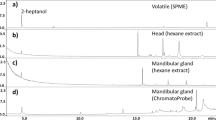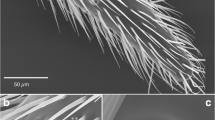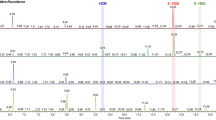Abstract
Studies on structure–activity relationships were carried out to characterize the response specificity of the benzoic acid cell of the female of the moth Bombyx mori by means of single sensillum electrophysiological recordings. We demonstrated that this cell type responds best to a natural key substance (benzoic acid) and has similar response profiles for less effective compounds, including various halogen substitutes of benzoic acid, benzaldehyde and other derivates of the key compound. Using different halogen substitutes (F, Cl, Br, I), we showed that the cellular response decreases with increasing atomic size of the substitute and that halogen substitutes were most effective in the meta-position. Thus, m-fluor benzoic acid was even more effective than benzoic acid. These results indicate that a critical feature of the stimulus molecule is the inductive effect generated by the halogen substitutes. Increasing the atomic size of the halogen substitute impairs the recognition of the molecule by the receptor cell, possibly due to steric effects. Decreasing the electron density in the aromatic ring improves the receptor response. The benzoic acid receptor cell can be considered as specialist despite not being involved in pheromone detection as it responds maximally to a key substance and has similar response profiles for less effective compounds.







Similar content being viewed by others
References
Barrozo RB, Kaissling KE (2002) Repetitive stimulation of olfactory receptor cells in female silkmoths Bombyx mori L. J Insect Physiol 48:825–834
Boeck J, Kaissling KE, Schneider D (1965) Insect olfactory receptors. Cold Spring Harbor Symp Quant Biol 30:263–280
De Brito Sanchez MG (1996) structure-activity relationships of antennal benzoic-acid receptor cells of female silkmoth Bombyx mori L. In: Elsner N, Schnitzler HU (eds) 24th Göttingen Neurobiology Conf, vol II. Thieme Verlag, Stuttgart, p 280
Dickens JC (1990) Specialized receptor neurons for pheromones and host plant odors in the boll weevil, Anthonomus grandis Boh (Coleoptera: Curculionidae). Chem Senses 15:311–331
Dykyj J, Repás M (1979) The vapour pressure of organic compounds (in Slovak). Veda, Bratislava
Hansson BS, Larsson MC, Leal WS (1999) Green leaf volatile-detecting olfactory receptor neurones display very high sensitivity and specificity in a scarab beetle. Physiol Entomol 24:121–126
Heinbockel T, Kaissling KE (1990) Sensitivity and inhibition of antennal benzoic-acid receptor cells of female silkmoth Bombyx mori L. Verh Dtsch Zool Ges 83:411
Heinbockel T, Kaissling KE (1996) Variability of olfactory receptor neuron responses of female silkmoths (Bombyx mori L) to benzoic acid and (±)-linalool. J Insect Physiol 42:565–578
Jonsson M, Anderson P (1999) Electrophysiological response to herbivore-induced host plant volatiles in the moth Spodoptera littoralis. Physiol Entomol 24:377–385
Kafka WA (1970) Molekulare Wechselwirkung bei der Erregung einzelner Riechzellen. Z Vergl Physiol 70:105–143
Kafka WA (1987) Similarity of reaction spectra and odor discrimination: single receptor cell recordings in Antherea polyphemus (Saturniidae). J Comp Physiol A 161:867–880
Kaissling KE, Meng LZ, Bestmann HJ (1989) Responses of bombykol receptor cells to (Z,E)-4,6- hexadecadiene and linalool. J Comp Physiol A 165:147–154
Kaissling KE (1987) R H Wright lectures on insect olfaction. In: Colbow K (ed) Simon Fraser University, Burnaby BC, Canada
Kaissling KE (1995) Single unit and electroantennogram recordings in insect olfactory organs. In: Spielman AI, Brand JG (eds) Experimental cell biology of taste and olfaction. Current techniques and protocols. CRC, Boca Raton, pp 316–377
Kaissling KE (1996) Peripheral mechanisms of pheromone reception in moths. Chem Senses 21:257–268
Kaissling KE, Priesner E (1970) Die Riechschwelle des Seidenspinners. Naturwissenschaften 57:23–28
Kaissling KE, Thorson J (1980) Insect olfactory sensilla: structural, chemical and electrical aspects of the functional organization. In: Satelle DB, Hall LM, Hildebrand JG (eds) Receptors for neurotransmitters, hormones and pheromones in insects. Elsevier, Amsterdam, pp 261–282
Kaissling KE, Kasang G, Bestmann HJ, Stransky W, Vostrowsky O (1978) Bombykol, a second pheromone component of the silkworm moth Bombyx mori. Sensory pathway and behavioral effect. Naturwissenschaften 65:382–384
Kodadova’ B (1996) Resolution of pheromone pulses in receptor cells of Antheraea polyphemus at different temperatures. J Comp Physiol A 179:301–310
Larsson MC, Leal WS, Hansson BS (2001) Olfactory receptor neurons detecting plant odours and male volatiles in Anomala cuprea beetles (Coleoptera: Scarabicidae) J Insect Physiol 47:1065–1076
Lide D (1988) CRC handbook of chemistry and physics. A ready-reference book of chemical and physical data. CRC, London
Ohloff G, Klein E (1962) Die absolute Konfiguration des Linalools durch Verknüpfung mit dem Pinansystem. Tetrahedron 18:37–42
Priesner E (1979) Progress in the analysis of pheromone receptor systems. Ann Zool Ecol Anim 11:533–546
Schneider D (1969) Insect olfaction: deciphering system for chemical message. Science 163:1031–1037
Schneider D (1984) Insect olfaction—our research endeavor. In: Dawson JJ, Enoch JM (eds) Foundations of sensory science. Springer, Berlin Heidelberg New York, pp 381–418
Schneider D (1992) 100 years of pheromone research—an essay on Lepidoptera. Naturwissenschaften 79:241–250
Steinbrecht RA (1970) Zur Morphometrie der Antenne des Seidenspinners, Bombyx mori L.: Zahl und Verteilung der Riechsensillen (Insecta, Lepidoptera). Z Morphol Tiere 68:93–126
Steinbrecht RA (1973) Der Feinbau olfaktorischer Sensillen des Seidenspinners (Insecta, Lepidoptera). Z Zellforsch 139:533–565
Steinbrecht RA (1987) Functional morphology of pheromone-sensitive sensilla. In: Prestwich GD, Blomquist GJ (eds) Pheromone biochemistry. Academic, New York, pp 353–384
Stensmyr MC, Larsson MC, Bice S, Hansson BC (2001) Detection of fruit- and flower-emitted volatiles by olfactory receptor neurons in the polyphagous fruit chafer Pachnoda marginata (Coleoptera: Cetoniinae). J Comp Physiol A 187:509–519
Todd JL, Baker TC (1993) Response of single antennal neurons of female cabbage loopers to behaviorally active attractants. Naturwissenschaften 80:183–186
Zar JH (1985) Biostatistical analysis. Prentice Hall, Englewood Cliffs
Ziesmann J, Valterova I, Haberkorn K, de Brito Sanchez MG, Kaissling KE (2000) Chemicals in laboratory room air stimulate olfactory neurons of female Bombyx mori. Chem Senses 25:31–37
Acknowledgements
We are very grateful to B. Pophof for invaluable help and support, to J. Kovensky for useful discussions on organic chemistry topics, to Didier Bourissou and Christelle Freund (Laboratory of Basic and Applied Heterochemistry, University Paul Sabatier of Toulouse) for much help with organic chemistry databases and to M. Gauthier, M. Giurfa and two anonymous referees for comments and corrections on earlier versions of the manuscript. Thanks are due to D. Conesa for language corrections. G. de Brito Sanchez acknowledges the support of C. Lazzari and J. Núñez and the doctoral fellowships of the Max-Planck Gesellschaft and the DAAD (German Academic Exchange Service).
Author information
Authors and Affiliations
Corresponding author
Rights and permissions
About this article
Cite this article
Sanchez, M.G.d.B., Kaissling, KE. The antennal benzoic acid receptor cell of the female silk moth Bombyx mori L.: structure–activity relationship studies with halogen substitutes. J Comp Physiol A 191, 189–196 (2005). https://doi.org/10.1007/s00359-004-0588-2
Received:
Revised:
Accepted:
Published:
Issue Date:
DOI: https://doi.org/10.1007/s00359-004-0588-2




